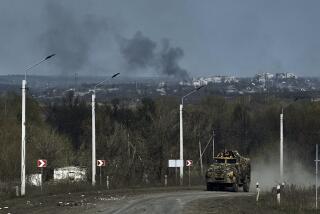U.S. intelligence reports cast doubt on war progress in Afghanistan
Reporting from Washington — Two new assessments by the U.S. intelligence community present a gloomy picture of the Afghanistan war, contradicting a more upbeat view expressed by military officials as the White House prepares to release a progress report on the 9-year-old conflict.
The classified intelligence reports contend that large swaths of Afghanistan are still at risk of falling to the Taliban, according to officials who were briefed on the National Intelligence Estimates on Afghanistan and Pakistan, which represent the collective view of more than a dozen intelligence agencies.
The reports, the subject of a recent closed hearing by the Senate Intelligence Committee, also say Pakistan’s government remains unwilling to stop its covert support for members of the Afghan Taliban who mount attacks against U.S. troops from the tribal areas of the neighboring nation. The officials declined to be named because they were discussing classified data.
The intelligence community’s analysis contrasts sharply with remarks last week by Defense Secretary Robert M. Gates, who said after visiting the region that he is convinced the administration’s strategy is turning around the Afghanistan war.
On Tuesday, military officers hotly contested the intelligence estimates, saying they are “dated” because the review period ended in September, as the last of additional American forces were arriving in Afghanistan. The defense officials said the assessments did not reflect recent gains.
“You are missing at least 2 1/2 months of intensive operations with the full complement of surge forces,” said a senior defense official, who added that intelligence analysts lack the “proximity and perspective that our forces have who are on the ground living this every single day.”
A senior intelligence official countered that claim, saying, “The notion that intelligence officers aren’t on the ground in Afghanistan and on the front lines in the fight against terrorism is preposterous. Our people are working side by side with the United States military and our foreign partners to thwart our common enemies.”
National Intelligence Estimates make use of analysis and information from all the intelligence agencies, including those that are part of the Pentagon.
The contrasting assessments illustrate the difficulty in making accurate predictions or gauging progress in Afghanistan. High-profile military operations in southern Afghanistan this year have gone much slower than initially expected. Military officials have said that a key measure of the Taliban’s strength will become clear only in the spring, when the traditional winter lull in fighting comes to an end.
President Obama on Tuesday signed off on a draft of the White House progress report after meeting with his top security advisors, Press Secretary Robert Gibbs said.
The White House review, to be released Thursday, will say that “there has been some important progress in halting the momentum of the Taliban in Afghanistan,” Gibbs said, and that “we’ve seen greater cooperation over the course of the past 18 months with the Pakistani government.”
It also will point to problems, including “the ongoing challenge and threat of safe havens in Pakistan,” he said.
Obama, who sent 30,000 additional troops to support his counterinsurgency strategy in Afghanistan, has pledged that military withdrawals would start in July 2011, contingent on conditions there. But Obama told members of the North Atlantic Treaty Organization last month that 2014 is the date by which the U.S. hopes to cede full control to Afghan forces, an indication that any 2011 drawdown is likely to be small.
The latter announcement was meant in part to emphasize to Pakistan that the U.S. intended to remain heavily engaged in the region, increasing pressure on the South Asian nation to cut its ties to Afghan Islamist insurgents, one U.S. official said.
It’s unclear to what extent the intelligence estimates examined the effect of the CIA’s increased use of Predator drone strikes against militants in Pakistan’s tribal areas — the main tool at American disposal in a country largely off limits to U.S. troops. But in concluding that the Taliban sanctuaries in those areas remain intact, the reports suggest that drone strikes have not been sufficient to stop militants from staging attacks against NATO forces.
A U.S. official regularly briefed on the program maintained that CIA operations in Pakistan — a euphemism for drone strikes— have greatly degraded militant havens over the last two years. “They’re making a hell of a difference” and “have saved numerous American lives,” he said.
The CIA has primary responsibility for counter-terrorism operations in Pakistan, with technical and human resources that afford a continual stream of information about events there.
Military commanders acknowledge that a failure to destroy the Taliban’s sanctuary in Pakistan could further delay the success of the Obama strategy. The intelligence estimates conclude that Pakistan is unwilling and unable to stop harboring and supporting the
Taliban, one U.S. official said.
Pakistan, which is due to receive $7.5 billion in U.S. civilian aid over three years, denies secretly backing the Taliban. However, intelligence gathered by the U.S. continues to suggest that elements of Pakistan’s security services arm, train and fund extremist militants, according to military and State Department documents disclosed this year by WikiLeaks.
Unless the Taliban sanctuaries in Pakistan are closed, “it’s going to take a lot longer” to achieve stability and hand over security responsibilities to Afghan troops, Army Maj. Gen. John C. Campbell, the senior commander in eastern Afghanistan, told reporters last week.
Campbell has been planning to close some of the remaining U.S. outposts near the Afghan-Pakistani border and consolidate his forces in areas where more Afghans live, in keeping with the U.S. strategy of protecting the population. But senior commanders are wary about decreasing the U.S. presence near the border, for fear that it would give insurgents an even larger sanctuary, officials said.
Army Gen. David H. Petraeus, the top NATO commander, is especially worried that U.S. gains in stabilizing southern Afghanistan will be at risk next year unless there is progress in curtailing the Taliban presence in and around the city of Quetta, in Pakistan’s Baluchistan province, several U.S. military officers said. The Pakistani army has troops in Baluchistan but has conducted no major combat operations there.
A senior U.S. military official said he remains hopeful that Pakistan will move against Taliban sanctuaries.
At some point, the officer said, “the Pakistan government will find it difficult to protect [or] ignore the snakes who they believe
will only bite the neighbor’s kids, and realize that these same snakes are part of the larger problem of an existential threat to their homeland.”
Last year Pakistan’s army retook the Swat Valley, a region that had fallen to militants. But the army has not moved into North Waziristan, the tribal area used by many insurgents to mount cross-border attacks in Afghanistan.
Petraeus told reporters last week that Gen. Ashfaq Kayani, the Pakistani army’s chief of staff, promised recently to conduct operations in North Waziristan. Petraeus acknowledged, though, that Kayani said he would do so “when the timing is right for Pakistani forces.”
The area is a stronghold for the Haqqani network, an Afghan insurgent group that has stepped up attacks across the border over the last year. The group, named for its leader, Jalaluddin Haqqani, has been the frequent target of CIA drone strikes in recent months.
Privately, a senior military official acknowledged that “there are no guarantees as to how Pakistan will ultimately address the sanctuary problem.”
Key members of Congress are watching the Obama strategy warily.
“Our political and diplomatic efforts are not in line with our military efforts,” said Rep. Mike Rogers (R-Mich.), who is under consideration as the next chairman of the House Intelligence Committee. “It may be time to consider a smaller troop footprint.”
Sen. Bob Casey (D-Pa.), a member of the Foreign Relations Committee, has not reached that conclusion but said, “From my point of view, we’ve got lots of unanswered questions in all three areas: security, governance and development.”
More to Read
Sign up for Essential California
The most important California stories and recommendations in your inbox every morning.
You may occasionally receive promotional content from the Los Angeles Times.











